Study on the Wake Characterization of a Horizontal-Axis Tidal Stream Turbine Utilizing a PIV System in a Large Circulating Water Tunnel
Abstract
1. Introduction
2. Materials and Methods
2.1. Turbine Apparatus
2.2. PIV Apparatus
3. Results
3.1. Power Performance of the Turbine
3.2. PIV Result
3.2.1. Flow and Turbulence Distributions Without the Turbine
3.2.2. Flow Distribution with the Turbine
3.2.3. Turbulence Distribution with the Turbine
3.2.4. Decay Zone in Wake Map
4. Conclusions
Author Contributions
Funding
Data Availability Statement
Conflicts of Interest
References
- Carley, S. State renewable energy electricity policies: An empirical evaluation of effectiveness. Energy Policy 2009, 37, 3071–3081. [Google Scholar]
- Østergaard, P.A.; Duic, N.; Noorollahi, Y.; Kalogirou, S. Renewable energy for sustainable development. Renew. Energy 2022, 199, 1145–1152. [Google Scholar]
- Deshmukh, M.K.G.; Sameeroddin, M.; Abdul, D.; Sattar, M.A. Renewable energy in the 21st century: A review. Mater. Today Proc. 2023, 80, 1756–1759. [Google Scholar]
- Güney, M.; Kaygusuz, K. Hydrokinetic energy conversion systems: A technology status review. Renew. Sustain. Energy Rev. 2010, 14, 2996–3004. [Google Scholar]
- Waters, S.; Aggidis, G. Tidal range technologies and state of the art in review. Renew. Sustain. Energy Rev. 2016, 59, 514–529. [Google Scholar]
- Shetty, C.; Priyam, A. A review on tidal energy technologies. Mater. Today Proc. 2022, 56, 2774–2779. [Google Scholar] [CrossRef]
- Roberts, A.; Thomas, B.; Sewell, P.; Khan, Z.; Balmain, S.; Gillman, J. Current tidal power technologies and their suitability for applications in coastal and marine areas. J. Ocean Eng. Mar. Energy 2016, 2, 227–245. [Google Scholar]
- Rourke, F.O.; Boyle, F.; Reynolds, A. Tidal energy update 2009. Appl. Energy 2010, 87, 398–409. [Google Scholar]
- Adcock, T.A.; Draper, S.; Nishino, T. Tidal power generation–a review of hydrodynamic modelling. Proc. Inst. Mech. Eng. Part A J. Power Energy 2015, 229, 755–771. [Google Scholar]
- Young, J.; Lai, J.C.; Platzer, M.F. A review of progress and challenges in flapping foil power generation. Prog. Aerosp. Sci. 2014, 67, 2–28. [Google Scholar]
- Kim, J.; Le, T.Q.; Ko, J.H.; Sitorus, P.E.; Tambunan, I.H.; Kang, T. Experimental and numerical study of a dual configuration for a flapping tidal current generator. Bioinspiration Biomim. 2015, 10, 046015. [Google Scholar] [CrossRef] [PubMed]
- Minute, R.P. Vertical Axis Tidal Current Turbine: Advantages and Challenges Review. Sci. Eng. 2016, 3, 64–71. [Google Scholar]
- Li, G.; Zhu, W. Tidal current energy harvesting technologies: A review of current status and life cycle assessment. Renew. Sustain. Energy Rev. 2023, 179, 113269. [Google Scholar] [CrossRef]
- Khan, M.; Bhuyan, G.; Iqbal, M.; Quaicoe, J. Hydrokinetic energy conversion systems and assessment of horizontal and vertical axis turbines for river and tidal applications: A technology status review. Appl. Energy 2009, 86, 1823–1835. [Google Scholar] [CrossRef]
- Qin, Z.; Tang, X.; Wu, Y.-T.; Lyu, S.-K. Advancement of tidal current generation technology in recent years: A review. Energies 2022, 15, 8042. [Google Scholar] [CrossRef]
- Zhang, J.; Wang, G.; Lin, X.; Zhou, Y.; Wang, R.; Chen, H. Experimental investigation of wake and thrust characteristics of a small-scale tidal stream turbine array. Ocean Eng. 2023, 283, 115038. [Google Scholar] [CrossRef]
- Lust, E.E.; Flack, K.A.; Luznik, L. Survey of the near wake of an axial-flow hydrokinetic turbine in quiescent conditions. Renew. Energy 2018, 129, 92–101. [Google Scholar] [CrossRef]
- Di Felice, F.; Capone, A.; Romano, G.P.; Pereira, F.A. Experimental study of the turbulent flow in the wake of a horizontal axis tidal current turbine. Renew. Energy 2023, 212, 17–34. [Google Scholar] [CrossRef]
- Nuernberg, M.; Tao, L. Experimental study of wake characteristics in tidal turbine arrays. Renew. Energy 2018, 127, 168–181. [Google Scholar] [CrossRef]
- Simmons, S.M.; McLelland, S.J.; Parsons, D.R.; Jordan, L.-B.; Murphy, B.J.; Murdoch, L. An investigation of the wake recovery of two model horizontal-axis tidal stream turbines measured in a laboratory flume with Particle Image Velocimetry. J. Hydro-Environ. Res. 2018, 19, 179–188. [Google Scholar] [CrossRef]
- Mycek, P.; Gaurier, B.; Germain, G.; Pinon, G.; Rivoalen, E. Experimental study of the turbulence intensity effects on marine current turbines behaviour. Part II: Two interacting turbines. Renew. Energy 2014, 68, 876–892. [Google Scholar] [CrossRef]
- Qian, Y.; Zhang, Y.; Sun, Y.; Zhang, H.; Zhang, Z.; Li, C. Experimental and numerical investigations on the performance and wake characteristics of a tidal turbine under yaw. Ocean Eng. 2023, 289, 116276. [Google Scholar] [CrossRef]
- Ebdon, T.; O’Doherty, D.; O’Doherty, T.; Mason-Jones, A. Modelling the effect of turbulence length scale on tidal turbine wakes using advanced turbulence models. In Proceedings of the 12th European Wave and Tidal Energy Conference, Cork, Ireland, 27 August–1 September 2017; p. 125. [Google Scholar]
- Li, C.; Zhang, Y.; Zheng, Y.; Yang, C.; Fernandez-Rodriguez, E. Numerical investigation on the wake and energy dissipation of tidal stream turbine with modified actuator line method. Ocean Eng. 2024, 293, 116608. [Google Scholar] [CrossRef]
- Niebuhr, C.; Schmidt, S.; van Dijk, M.; Smith, L.; Neary, V. A review of commercial numerical modelling approaches for axial hydrokinetic turbine wake analysis in channel flow. Renew. Sustain. Energy Rev. 2022, 158, 112151. [Google Scholar] [CrossRef]
- Silva, P.A.; Oliviera, T.F.; Brasil, A.C., Jr.; Vaz, J.R. Numerical study of wake characteristics in a horizontal-axis hydrokinetic turbine. An. Acad. Bras. Ciências 2016, 88, 2441–2456. [Google Scholar] [CrossRef]
- Stallard, T.; Collings, R.; Feng, T.; Whelan, J. Interactions between tidal turbine wakes: Experimental study of a group of three-bladed rotors. Philos. Trans. R. Soc. A Math. Phys. Eng. Sci. 2013, 371, 20120159. [Google Scholar]
- Mason-Jones, A.; O’Doherty, D.M.; Morris, C.E.; O’Doherty, T.; Byrne, C.; Prickett, P.W.; Grosvenor, R.I.; Owen, I.; Tedds, S.; Poole, R. Non-dimensional scaling of tidal stream turbines. Energy 2012, 44, 820–829. [Google Scholar] [CrossRef]
- Neunaber, I.; Hölling, M.; Stevens, R.J.; Schepers, G.; Peinke, J. Distinct turbulent regions in the wake of a wind turbine and their inflow-dependent locations: The creation of a wake map. Energies 2020, 13, 5392. [Google Scholar] [CrossRef]
- Kang, S.; Kim, Y.; Lee, J.; Khosronejad, A.; Yang, X. Wake interactions of two horizontal axis tidal turbines in tandem. Ocean Eng. 2022, 254, 111331. [Google Scholar] [CrossRef]
- Martinat, G.; Braza, M.; Hoarau, Y.; Harran, G. Turbulence modelling of the flow past a pitching NACA0012 airfoil at 105 and 106 Reynolds numbers. J. Fluids Struct. 2008, 24, 1294–1303. [Google Scholar] [CrossRef]
- Gaurier, B.; Druault, P.; Ikhennicheu, M.; Germain, G. Experimental analysis of the shear flow effect on tidal turbine blade root force from three-dimensional mean flow reconstruction. Philos. Trans. R. Soc. A 2020, 378, 20200001. [Google Scholar] [CrossRef] [PubMed]
- Laws, N.D.; Epps, B.P. Hydrokinetic energy conversion: Technology, research, and outlook. Renew. Sustain. Energy Rev. 2016, 57, 1245–1259. [Google Scholar]
- Porté-Agel, F.; Bastankhah, M.; Shamsoddin, S. Wind-turbine and wind-farm flows: A review. Bound.-Layer Meteorol. 2020, 174, 1–59. [Google Scholar]
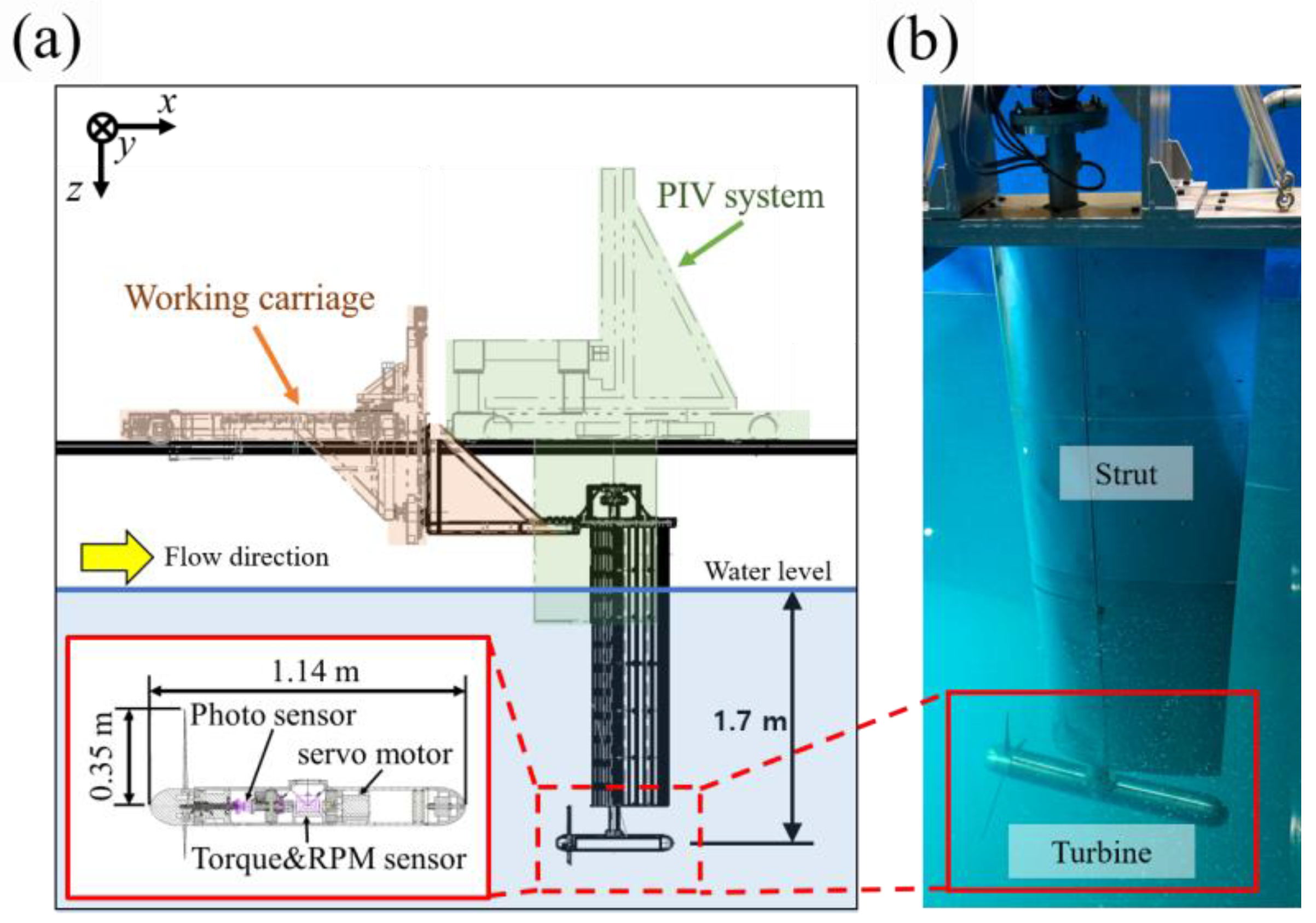
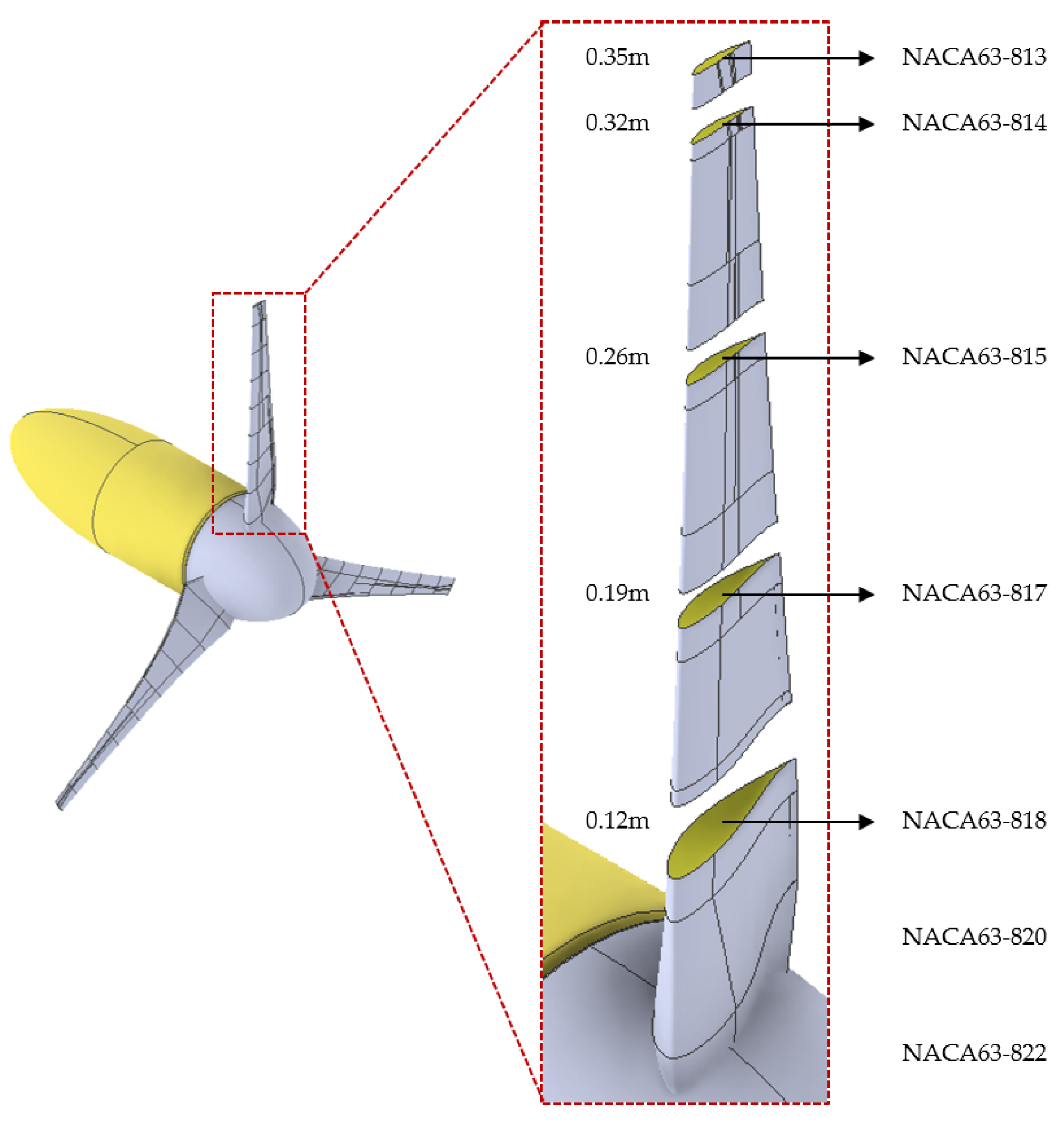

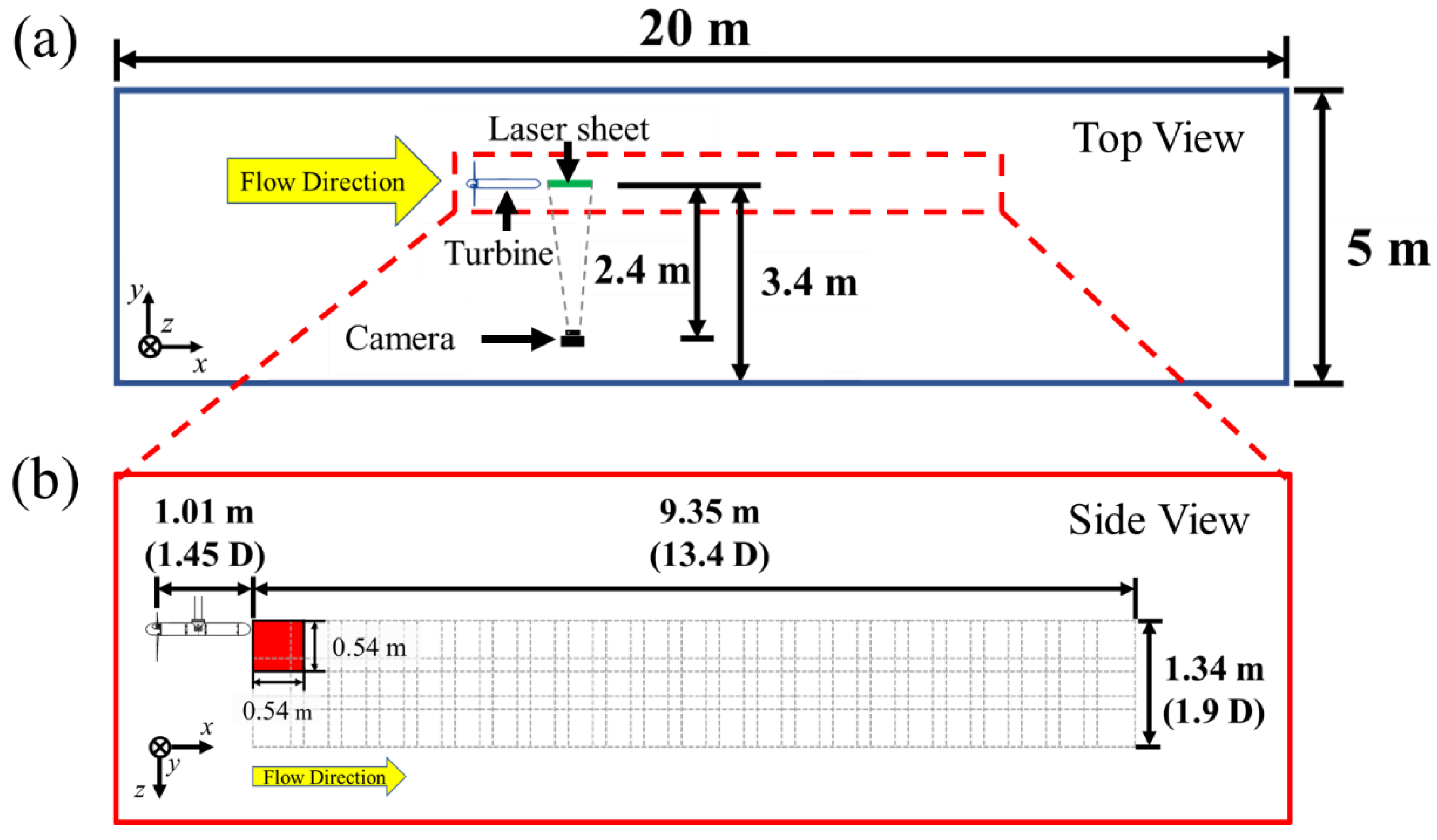

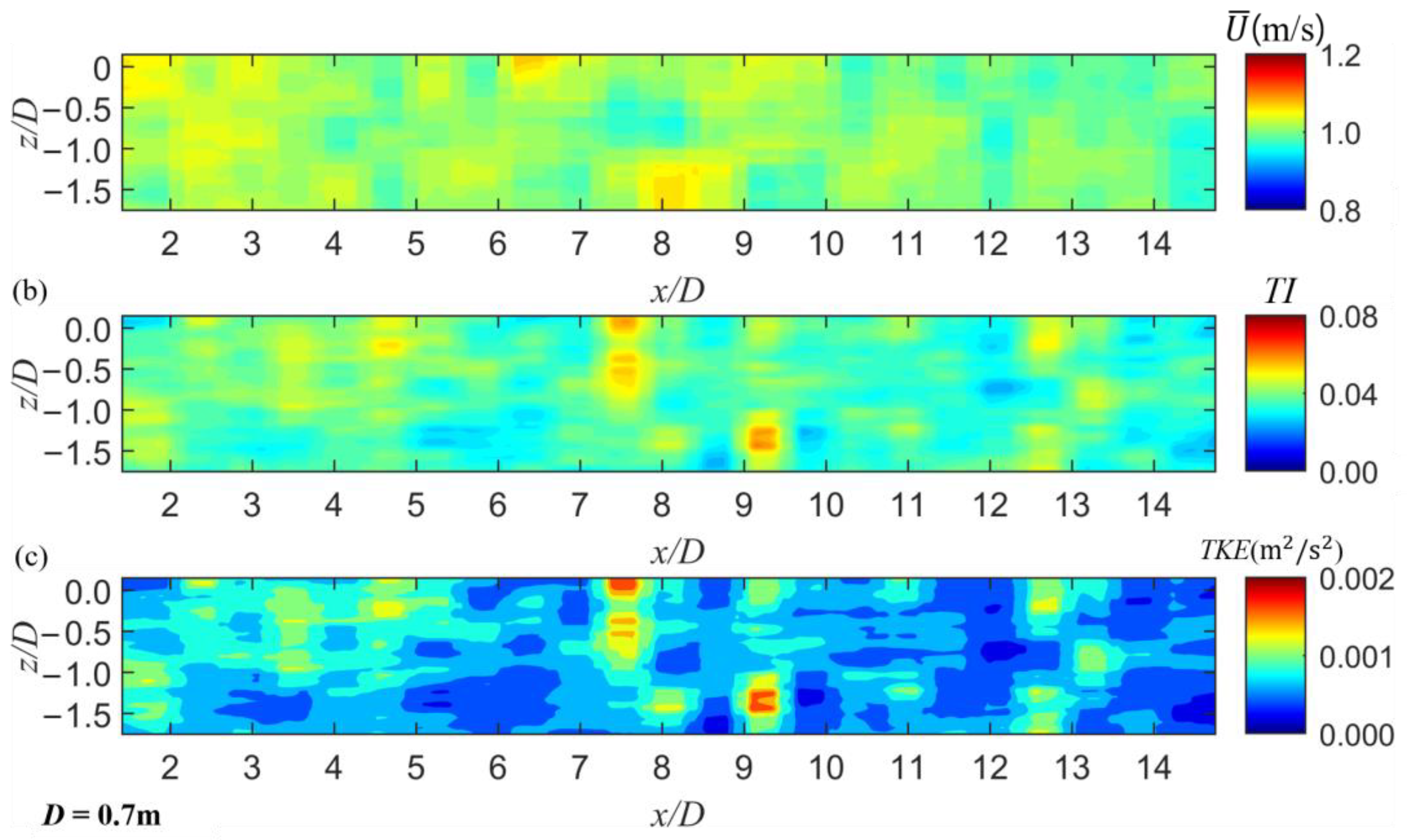


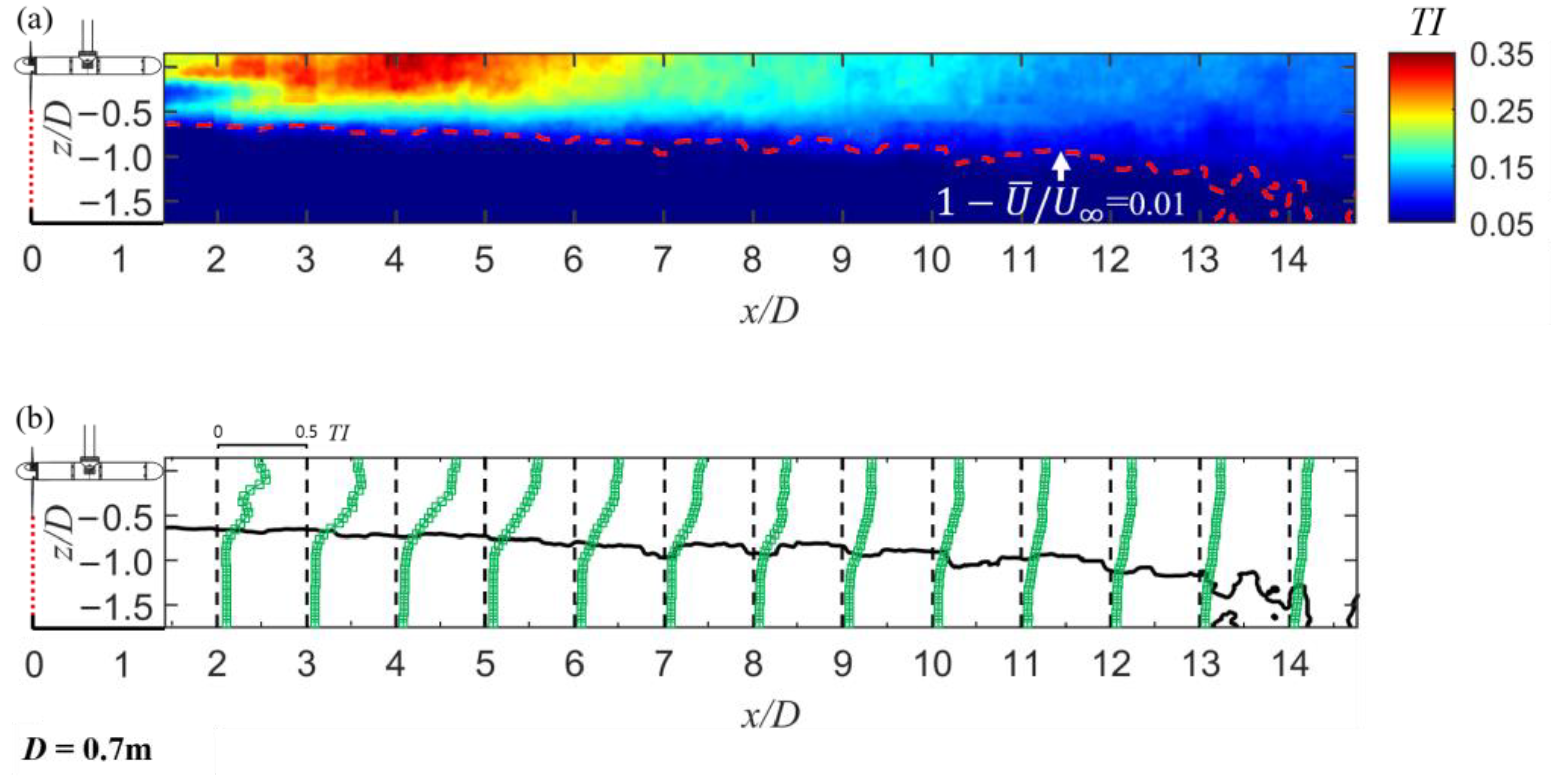




Disclaimer/Publisher’s Note: The statements, opinions and data contained in all publications are solely those of the individual author(s) and contributor(s) and not of MDPI and/or the editor(s). MDPI and/or the editor(s) disclaim responsibility for any injury to people or property resulting from any ideas, methods, instructions or products referred to in the content. |
© 2025 by the authors. Licensee MDPI, Basel, Switzerland. This article is an open access article distributed under the terms and conditions of the Creative Commons Attribution (CC BY) license (https://creativecommons.org/licenses/by/4.0/).
Share and Cite
Jung, S.; Lee, H.; Jeong, D.; Kim, J.; Ko, J.H. Study on the Wake Characterization of a Horizontal-Axis Tidal Stream Turbine Utilizing a PIV System in a Large Circulating Water Tunnel. Energies 2025, 18, 1870. https://doi.org/10.3390/en18071870
Jung S, Lee H, Jeong D, Kim J, Ko JH. Study on the Wake Characterization of a Horizontal-Axis Tidal Stream Turbine Utilizing a PIV System in a Large Circulating Water Tunnel. Energies. 2025; 18(7):1870. https://doi.org/10.3390/en18071870
Chicago/Turabian StyleJung, Sejin, Heebum Lee, Dasom Jeong, Jihoon Kim, and Jin Hwan Ko. 2025. "Study on the Wake Characterization of a Horizontal-Axis Tidal Stream Turbine Utilizing a PIV System in a Large Circulating Water Tunnel" Energies 18, no. 7: 1870. https://doi.org/10.3390/en18071870
APA StyleJung, S., Lee, H., Jeong, D., Kim, J., & Ko, J. H. (2025). Study on the Wake Characterization of a Horizontal-Axis Tidal Stream Turbine Utilizing a PIV System in a Large Circulating Water Tunnel. Energies, 18(7), 1870. https://doi.org/10.3390/en18071870





